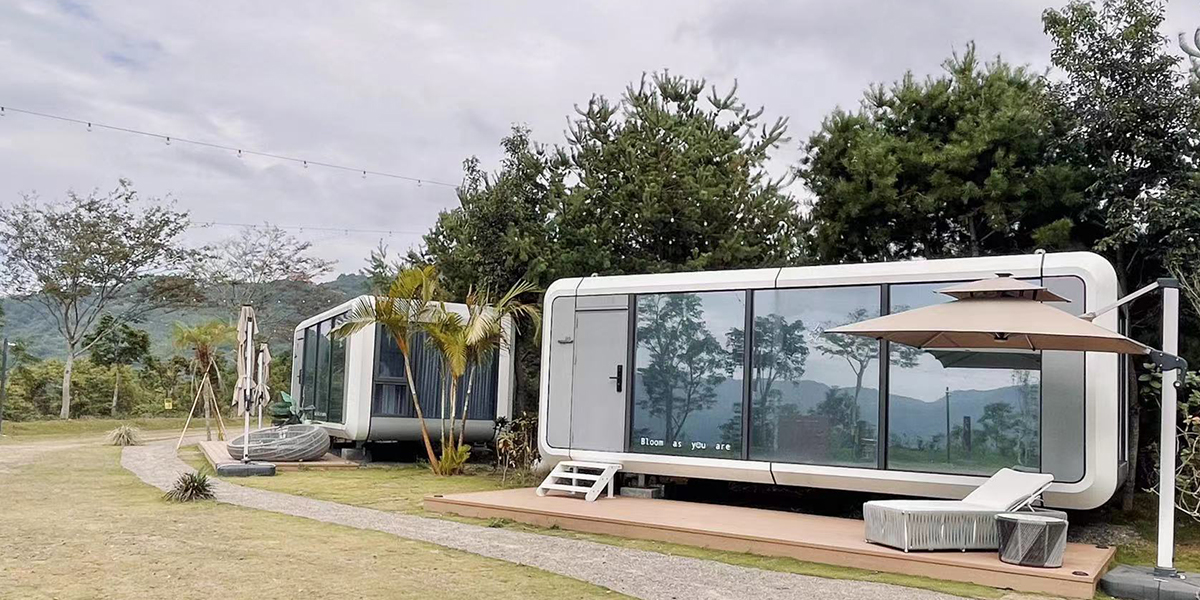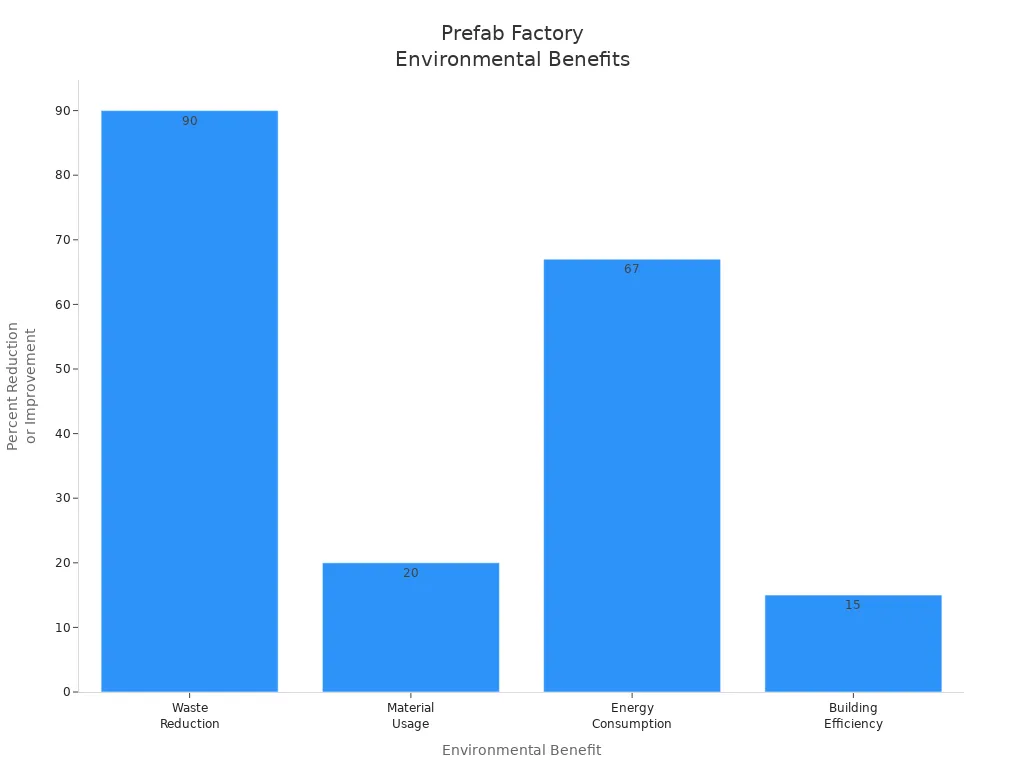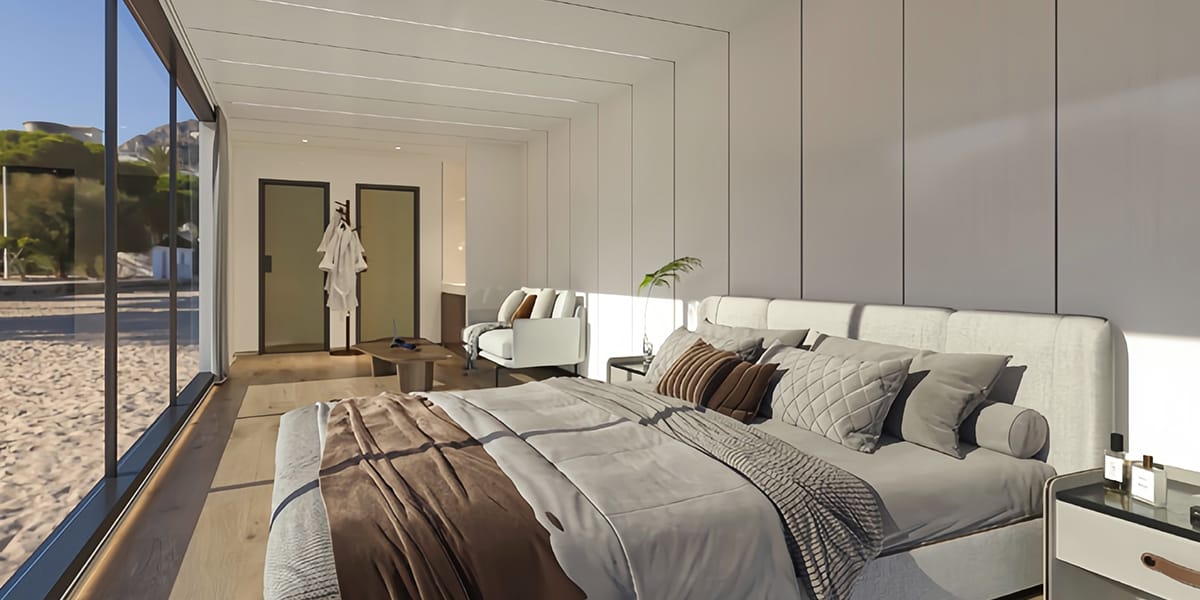
21 Jul 7 Tips for Choosing an Eco-Friendly Prefab Capsule House
Table of Contents
Ready to pick the best prefab capsule house for green living? Remember these seven tips: materials, energy efficiency, certifications, water saving, air quality, how the maker works, and if it can be recycled later. Make sure the size and style fit your life. Use this list to help you choose well!
Key Takeaways
Pick prefab capsule houses that use eco-friendly materials like bamboo, recycled metals, and reclaimed wood. These materials help protect the earth and last a long time.
Look for energy-saving features like strong insulation, double-glazed windows, and solar panels. These features help you save money and stay comfortable all year.
Choose homes with eco certifications and water-saving fixtures. Think about modular designs that are easy to upgrade, recycle, and move. This helps cut down on waste and supports green living.
Materials
Sustainable Choices
When you want a sustainable capsule house, look at the materials. You need your prefab capsule house to last a long time. It should not hurt the planet much. Many builders use eco-friendly things like bamboo, reclaimed wood, and recycled metals. These materials help lower waste and save nature.
Bamboo grows quickly and is good for floors and walls.
Recycled steel and aluminum come from recycling, so there is less waste and less pollution.
Reclaimed wood uses old wood again and makes your home look special.
Some companies use biodegradable composites with help from green groups.
These materials make capsule houses strong and nice to look at. They are also better for the earth. Modular designs let you reuse or recycle parts if you move or change your house. This helps lower your carbon footprint and keeps trash out of landfills.
Low-VOC Options
You should also care about your health. Many prefab capsule houses use paints, glues, and plastics that let out VOCs. VOCs are chemicals that can make you feel sick. Some people get headaches or allergies from them. People who are sensitive to chemicals can feel worse in homes with lots of VOCs.
Tip: Pick low-VOC or non-toxic paints, sealants, and insulation. This keeps your air clean and safe for your family.
Good insulation and mold-resistant materials are important, too. They stop water and mold, which can make you sick. When you pick capsule houses with these things, your home is green and healthy.
Energy Efficiency
Insulation & Windows
You want your prefab capsule house to feel good all year. Good insulation and strong windows help a lot. Super-insulation keeps heat inside in winter. It also keeps heat out in summer. Double-glazed windows stop cold air from coming in. They also keep your home quiet. These things mean you do not need as much heating or cooling. You use less energy and save money.
Tip: Pick capsule homes with thermal barriers and climate control. These features help you save energy and money.
If you pick an off-grid capsule house, you need insulation that works everywhere. You will feel warm in cold places and cool in hot places.
Solar & Energy Systems
Many off-grid capsule homes have solar panels. Solar panels give you clean energy even far from cities. You can live in remote places and still have power. These homes often use smart thermostats and smart lights. These tools help you use less electricity every day.
Energy-saving fridges and washers use less power.
Smart thermostats keep your home at the right temperature.
Smart lights turn off when you leave a room.
Solar panels give you power for off-grid living.
With these systems, you get the energy efficiency you want. Off-grid capsule homes let you enjoy nature and stay comfortable.
Certifications
Eco Labels
When you look for a prefab capsule house, check for eco labels. These labels show that your home meets green standards. You might see labels like LEED, Energy Star, or GreenGuard. Each one means something different. LEED stands for Leadership in Energy and Environmental Design. It tells you that your home saves energy and uses safe materials. Energy Star means your house uses less power. GreenGuard shows that the air inside your home stays clean.
Tip: Always ask the builder about these labels. If you see them, you know the house is better for you and the planet.
Standards
Third-party standards matter a lot. They make sure your prefab capsule house is truly eco-friendly. When a trusted group checks the house, you can trust the results. These groups test things like energy use, water savings, and air quality. They also look at how the house was built. If a house passes, you know it meets strict rules.
Here’s a quick list of what good standards cover:
Energy use and savings
Water conservation
Safe building materials
Healthy indoor air
You do not have to guess if a house is green. Certifications give you proof. They help you compare different homes. You can feel good about your choice and know you are helping the earth.
Water Conservation
Fixtures
You can save a lot of water just by picking the right fixtures for your prefab capsule house. Low-flow toilets, faucets, and showerheads use much less water than regular ones. These smart choices help you cut down on waste every single day. If you live in off-grid capsule homes, you need to make every drop count. Water-saving fixtures let you enjoy comfort without using too much of this precious resource.
Tip: Check for WaterSense labels on fixtures. These products meet strict standards for water efficiency.
You might not notice leaks right away, but even a small drip can waste gallons over time. Regularly check your fixtures and pipes. Fix leaks fast to stop water loss and prevent mold. Mold can grow quickly in small spaces, so staying on top of maintenance keeps your home healthy.
Rainwater & Greywater
Off-grid capsule homes often use self-sufficient systems to collect and reuse water. Rainwater harvesting lets you catch rain from your roof and store it for later. You can use this water for your garden, cleaning, or even flushing toilets. Greywater systems take water from sinks and showers and reuse it for things like watering plants.
These self-sufficient systems can make a big difference. Rainwater harvesting can cut your need for city water by up to 50%. Greywater reuse can lower your water use by about 30%. That means you save a lot of water every year, which is great for the planet and your wallet.
If you want to live in off-grid capsule homes, these water solutions help you stay independent. You use less water, pay less, and help the environment at the same time.
Indoor Air Quality
 Ventilation
Ventilation
You want your home to feel fresh every day. Good ventilation helps you breathe easier and keeps your space healthy. In small homes, stale air and moisture can build up fast. That is why you need a strong ventilation system. Many modern homes use heat recovery ventilators (HRV). These systems pull in fresh air and push out old air. They also keep the temperature steady, so you do not lose heat in winter or cool air in summer.
Tip: Open your windows when you can. Letting in outside air helps clear out dust and smells. If you live in a place with lots of pollen or pollution, use an air purifier to keep your air clean.
Airtight homes need special care. Builders often use blower door tests to check for leaks. This helps make sure air only comes in and out where you want it to. You get better control over your indoor air and less risk of mold.
Non-Toxic Finishes
You spend a lot of time inside your home. The finishes you choose matter for your health. Many paints, glues, and sealants let out chemicals called VOCs. These can make you feel sick or give you headaches. You can avoid this by picking non-toxic finishes. Here is what to look for:
Formaldehyde-free wood and insulation like dense-pack cellulose or mineral wool
Vapor-open, breathable walls that let moisture escape
Airtight construction with controlled ventilation
Some insulation, like spray foam, can still let out chemicals. Try to pick safer options when you can. When you use non-toxic finishes and good building methods, your air stays cleaner for years. You and your family will feel better every day.
Manufacturer Practices
Factory Process
Choosing sustainable capsule houses helps the earth from the start. Factories build these homes inside, so there is less waste. Machines cut materials very carefully. This means almost nothing gets thrown away. Factories can recycle scraps and use green materials more easily. There is also less pollution from building.
Here is a table that shows how factory-built homes help the environment:
Environmental Benefit | Description | Impact Compared to On-site Construction |
|---|---|---|
Waste Reduction | Factories make less waste like wood, cardboard, plastic, and concrete. | Up to 90% less waste made |
Material Usage | Factories order just what they need, so there is less extra. | Up to 20% less material used |
Energy Consumption | Factories use less energy and do not need as much work at the building site. | About 67% less energy used |
Building Efficiency | Homes built in factories have better insulation and are sealed tightly. | Up to 15% more energy-efficient |
Recycling and Sustainable Materials | Factories sort waste better and use more green materials. | More recycling and eco-friendly materials used |
Site Disturbance | Building off-site means less harm to the land and nature. | Much less damage to the building site |

You get a home that is fast to build and good for the planet. These homes use less energy and make less mess at your site.
Durability
You want your home to last a long time. Sustainable capsule houses are strong like regular homes. If you take care of them, they can last 30 to 50 years or more. Factories use strong materials like steel, concrete, and recycled things. They follow strict rules to keep your home safe.
Manufacturers use smart ways to make your home tough:
Anti-seismic steel frames help during earthquakes.
Aluminum plates stop rust and make the house stronger.
Thick insulation keeps your home warm and saves energy.
Special paint stops rust and weather damage.
Windows have double glass for safety and warmth.
Fire-resistant walls help keep you safe in a fire.
You do not have to fix things as often because these homes need less work. The small size means there are fewer things to repair. If you check your home often and take care of it, your capsule house will stay strong and cozy for many years.
End-of-Life
Modularity
Thinking about the future of your prefab capsule house is important. Modularity helps a lot with this. Modular design means your house is made of different parts. These parts fit together like blocks. You can take the house apart if you want to move. You can also upgrade or recycle it later. This makes things easier for you and better for the earth.
You can take the house apart without breaking it.
Each piece is light and simple to carry.
Standard parts make swapping or recycling easy.
Tip: Modular homes let you change your home without building a new one. You save money and make less waste.
Recyclability
Prefab capsule houses use materials that can be recycled later. Builders pick things like steel, aluminum, and reclaimed wood. These materials come from systems where they get used again. When you take your house apart, you can sort the pieces. Then you send them to recycling centers.
Steel and aluminum can be used in new buildings.
Wood can be made into furniture or new panels.
Some plastics and composites can be recycled too.
You help the planet by keeping old stuff out of landfills. Modular design and recyclable parts help create a circular economy. Your house can be used again, even after you leave.
Picking an eco-friendly prefab capsule house means you should think about what is important to you.
How much energy it saves
How well it uses space
If it fits your way of living
How long it takes to build
If the materials last a long time
If you can change things to fit you
How it affects the environment
Look at guides and FAQs to learn about green features. Ask questions if you are not sure. Choose what works best for you and what you care about. 🌱
FAQ
How long does it take to build a prefab capsule house?
You can get your prefab capsule house in just a few weeks. Most builders finish the job much faster than regular homes.
Tip: Ask your builder for a timeline before you start.
Can I move my prefab capsule house to a new location?
Yes, you can move most prefab capsule houses. The modular design makes moving easy. You just take it apart, move the pieces, and set it up again.
Are prefab capsule houses safe in bad weather?
Prefab capsule houses use strong materials. They stand up to wind, rain, and snow. Many models have extra features for storms or earthquakes.
Always check the safety rating for your area.




 Ventilation
Ventilation